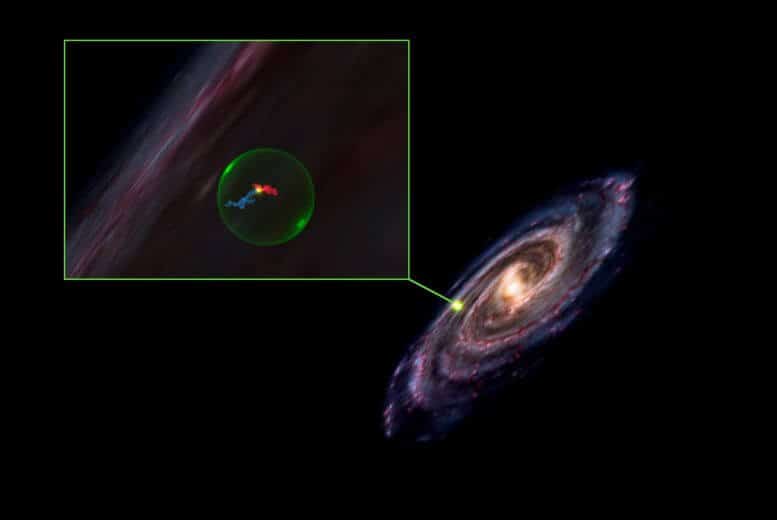The "hole" spans about 150 farsecs - close to 500 light years - and is in the sky between the constellations Perseus and Taurus (Bull). The research team, which operates at the Center for Astrophysics Harvard and the Smithsonian, believe the hole was created by supernovae that exploded about ten million years ago

Astronomers analyzing XNUMXD maps of the shapes and sizes of nearby molecular clouds have discovered a huge hole in space.
The ball-shaped hole, described in an article in the Astrophysical Journal Letters, spans about 150 farsecs—nearly 500 light years—and is in the sky between the constellations Perseus and Taurus (the bull). The research team, which operates at the Center for Astrophysics Harvard and the Smithsonian, believe the hole was created by supernovae that exploded about ten million years ago.
The mysterious hole is surrounded by the Perseus and Taurus molecular clouds—regions of space where stars form.
"Hundreds of stars are being formed or already exist on the surface of this giant bubble," says Shmuel Biali, a postdoctoral researcher at the Institute for Theory and Calculations at the Center for Astrophysics who led the research. "We have two theories - one supernova exploded in the core of the bubble and pushed gas out and created what we call the Perseus-Taurus superbubble, or a series of supernovas that occurred over millions of years created it over time."
The findings show that the Perseus and Taurus molecular clouds are not independent structures in space, but were formed together from the same supernova shock wave. "This shows that when a star dies, its supernova creates a chain of events that can eventually lead to the birth of new stars," explains Biali.
Credit: Jason Chambers/Center for Astrophysics | Harvard & Smithsonian
The XNUMXD map of the bubble and its surrounding clouds was created using new data from Gaia, an observatory in space launched by the European Space Agency.
Detailed descriptions of how the XNUMXD maps of the Perseus and Taurus molecular clouds and other nearby clouds were analyzed appear in a separate study published today in the Astrophysical Journal. Both studies used a reconstruction of dust created by scientists at the Max Planck Institute for Astronomy in Germany.
The maps are the first time that molecular clouds have been mapped in three dimensions. Previous pictures of the clouds were limited to two dimensions.
"We can see these clouds for decades, but we never knew their true shape, depth and thickness. We weren't even sure how far away the clouds were," says Kathryn Zucker, a postdoctoral researcher at the Center for Astrophysics who led the research in the Astrophysical Journal. "Now we know where they are with an uncertainty of only 1%, and this allows us to distinguish this guy among them."
עAnd on the topic on the science website:
- Scientists recreated the history of the Milky Way
- The Israel Physics Society award to PhD student Moshe Goldstein from the Department of Physics at Bar-Ilan University
- Zvir Perseus - a photograph of Chandra that required a total of 270 hours of viewing
- Scientists have been able to identify the genes that influence a healthier aging process
- Astronomers: Tonight it will be possible to witness the fall of meteorites

9 תגובות
I thought minimum Boötes Void.
It is interesting that there is no talk of finding the neutron star / black hole in the vicinity.
You don't understand anything!! This is one of the 7 Dragon Balls
A wormhole
So it somewhat contradicts the theory of the creation of the starship after the big bang, if at least 10 million years have passed and the dust is still scattered without a change in its density?
And it's enough to censor my messages because you don't like a girl who answers smoks in a language they understand
So this pretty much contradicts the theory of the creation of stars after the big bang or that 10 million years is not enough for this dust to take a more "solid" form
Eli, here we are not talking about a black hole (dense mass) but a guy of lack of mass (a kind of 'bubble') which is estimated to have been caused by a huge explosion.
Interestingly, there was a whole episode in Best Trek and Wigger about just such a phenomenon, and this is from the late 90s...
There is nothing mysterious here, this is not the first time such a hole has been discovered and it is clear that its cause is supernova(s). The title of the article should have been "hole for the milk path mapped for the first time in XNUMXD", because that is the real news here.
How is it possible to see 'molecular clouds' in a black hole? After all, the experts 'taught' us that black is something that swallows everything up to its core and therefore its name "black hole"